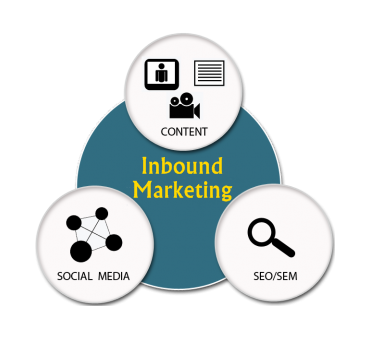 Inbound Marketing
Inbound Marketing
Inbound marketing is the practice of online marketing that deliberately uses a combination of search engine optimization (SEO), various social media channels, and blogging to publish content that people will seek-out, find and engage with. Let’s look at some of the essential elements to an effective inbound marketing practice, include website optimization, high-quality blogging, social networking, and eNewsletters & useful content.
1. Website Optimization
Having an optimized website does a lot for search engine results page (SERP) ranking. However, with inbound marketing, high ranking is not the only goal, and it’s not the only desired outcome. Good optimization helps make sure your site seldom deviates from its topic. When you look at keywords, you’re looking at a long list of potential topics for you to write about and share with your visitors. When done right, SEO leaves no room for accidentally off topic content, and consequently it ensures that your site is a wealthy source of information for people interested in your topic. This is key to inbound marketing, because remember, people want answers and they want them from sources that appear trustworthy.
2. High Quality Blogging
“High quality” blogs are essential to successful inbound marketing. So let’s define “high quality.” Well written. Providing fresh, on topic content that is remarkable. Remarkable meaning that it is worthy of reader comment, forwarding, bookmarking and reference.
Essentially, then, high quality blogs give people a reason to come to your site for reasons other than being sold on something. When you regularly write, publish, and provide meaningful, useful information on your blog, people become engaged with you. There’s no transfer of monetary currency in this practice, but there is an investment of people’s time. And that investment builds the foundation for a relationship whether people are aware of it, or not. This, because time invested with you via your blog, is time not invested elsewhere, or with our competitors.
A good, high quality blog, also establishes you and your company as a published authority in your area of expertise. A high quality blog that establishes perceived authority, can easily go viral, with the willing click of a mouse. This creates more inbound links, more publicity, more visits, and a wider reach for your company.
3. Social Networking
Yes, we brought out social media as an inbound marketing tool. Why? For the most part, it should fall in the realm of “passive” marketing. In other words, it’s not a place to pour your ads, discounts and company bravado. You can occasionally share this stuff, but the main point of social networking is to connect and network.
This is all merely an overview of principles, but there is much more depth in practice and execution. Studied rules like having at least one CTA (call-to-action) on every page, or making sure people can find the sign up for your newsletter are proven practices of good inbound marketing.
4. eNewsletters & Useful Content
There’s a lot of debate about whether e-mail newsletters really work. They do,but only if you are effective in using the proper steps to getting visitors to sign up. You can no longer send an email blast, or merely offer the newsletter subscription in tiny print hidden somewhere in the corner of your site. That doesn’t work anymore. Better technology and discerning readers deaden the one-time effectiveness of that.
So what’s necessary in the new realm of new, inbound marketing? Offering free, meaningful content. Things like white papers. If the content is good enough for people to want it, you can request name and email before allowing the download. Most people don’t mind a short, sweet few fields to complete, so long as they receive valuable content in their inbox as a result of it. Once you have that contact information, you continue to nurture it, not drown it, with more and more desirable content.
In summary, then, all these inbound marketing tools all have a few things in common. On the whole, they:
-
- Generate and continue to feed interest
- Increase your level of authority on your product or service subject matter
- Establish your brand without appearing self-promoting




5 Comments
Comments are closed.